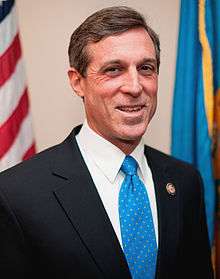Delaware Democratic Party
Delaware Democratic Party | |
|---|---|
|
| |
| Chairperson | Erik Raser-Schramm |
| Headquarters | New Castle, DE |
| Ideology |
Modern liberalism Third Way |
| National affiliation | Democratic Party |
| Colors | Blue |
| Seats in the Upper House |
11 / 21 |
| Seats in the Lower House |
25 / 41 |
| Website | |
| www.deldems.org | |
The Delaware Democratic Party is the affiliate of the Democratic Party in the state of Delaware, headquartered in unincorporated New Castle County.
Erik Raser-Schramm is the state Chair. The Delaware Democratic Party is one of the two biggest parties in the state of Delaware (the other being the Republican Party) and has existed since the Jacksonian Democrats broke away from the Federalists in 1825. Besides their most prominent current political figure, former Vice President Joe Biden, the party occupies all federal seats for the state in Congress and currently has majority control over the state legislative and executive branch.
History of the party
Party creation
As the first state of the United States, Delaware was at the forefront of the creation in U.S. political parties. The origins of the Delaware Democratic Party can be traced back to the original anti-federalist party. While key difference divide this part from the Democratic Party today, key issues involving government involvement and ideologies such as Jeffersonian and Jacksonian can be linked to modern day ideals of the Delaware Democratic party.[1] Yet, despite being one of the first states with true parties, the spiritual predecessor of the Democratic party struggled to support its agenda in the state. It wasn't until the splitting of parties into federalists and Jacksonians that the Democratic party got its first true start. With only one bad loss in 1855 to the American Party, the Democratic Party dominated politics up until the end of Reconstruction in the United States.[1] Most fascinating of all, was how the party maintained its popularity during the Civil War. Despite being a northern state, Delaware Democrats opposed the abolition of slavery and named themselves "the white man's party" as they fought the Republican congress during Reconstruction.[1] With 36 years of election dominance, the Democrats eventually fell out of power due to one major factor, the growth of industry in the state.
An era of weakness
Following the ousting of the Democrats in both the federal and state sector, the Republican party remained the dominate party throughout the early 1900s and up until World War II. Even when John Addicks attempted to illegally purchase the Republican seat in the U.S. Senate, the Democrats were unable to capitalize. To emphasize just how far the party had fallen, the seat that Addicks attempted to take lay vacant for four consecutive terms with the Democrats unable to take it despite the clear corrupt actions of the Republican candidate Addicks.[1] From 1897 to 1936, Delaware Democrats were irrelevant in politics with Republicans either dominating the state senate and house of Representatives or the Democrats completely absent from federal politics. With the power of industry overriding agriculture, the Democratic Party was not be able to regain an equal footing in the state until Franklin D. Roosevelt came into office.
Trading time with the Republicans
Following its period of weakness, the Democratic Party of Delaware began to regain an equal foothold with its Republican Rival following World War II. While evidence Republican domination could be still be see in the form of J. Caleb Boggs and John J. Williams, the third member of this "Big Three" was a Democrat named Elbert Carvel. Carvel served two terms as the governor of the state and helped keep his party relevant even when they did not control the state.[1] Despite what occurred in the past, The Democrats of the late 1970s to 2000 held an equal footing in the state, neither party gaining serious ground on the other. Democrats would end up holding the Governor position in the state for 30 years in comparison to their counterparts possession of the position for 29.[1] Even after the Republicans had held the office of the Governor more than 20 years, the Democrats simply took it back and continue to occupy it to this day.
Recent glory
In the past few years, the Democratic Party has risen to become the most popular party in the state of Delaware. The party has control at the state level over the Executive branch and the Legislative branch.
Platform
The Delaware Democratic Party basis of its platform on the policy of inclusiveness and using this policy to help strengthen and assist the citizens it is tasked to govern.[2]
- Families: The Delaware Democratic Party believes that there are many types of families in the world and that all of them should be supported. No matter what a family looks like, the party believe that diverse families make up the backbone of American society. With policies supporting social security, women's choice, reduction of poverty, and improved health care, the Democratic party of Delaware hopes to strength family units that make up society.[2]
- Education: For the Delaware Democratic Party, all children are entitled to a good public education and enrollment to college if they choose to pursue it. The party seeks to make education affordable for everyone, improve the system damaged by No Child Left Behind, and expanding education opportunities.[2]
- Environment: As a members of the United States, the Delaware Democratic Party supports the use of clean energy and promotes the usage of green methods to improve the environment. Options such as offering incentives to those who utilize green methods, supporting energy transition from fossil fuels to alternative fuels, and increasing public transportation are just some of the things that the Delaware Democrats support.[2]
- Economy: In pursuing economic interests, the Delaware Democrats believe the most vital aspect is strong leadership. Democrats for this state support increased leadership for their state in the federal realm, account leaders in their state, and developing ways for incorporating new technology and ideologies in their government and economic system.[2]
- Organized labor: In support of those employed in Delaware, the party seeks to enact policies such as a living wages, enforce fair collective bargaining agreements, and require employers to provide insurance for their employees.[2]
- Safety and emergency preparedness: The Democratic Party of Delaware believes that one of the main responsibilities of government is protecting its citizens. The party pledges to serve its citizens in office by focusing on crime prevention, allocating resources to prevent disasters and speed up recovery, and make sure that the state is prepared to deal with emergencies and prevent social injustices.[2]
- Military and veteran services: As one of the vital cogs of America, the Delaware Democrats support programs and opportunities that assist those who serve or have served in the military. The party believes in keeping the Dover airbase open, ensure adequate funds for veterans, and supporting the families of those who fight on behalf of the United States.[2]
- Civil rights: The party's stance on civil rights is a position in support of diversity and against all forms of discrimination. The Democratic Party of Delaware wants equality in the workplace, larger penalties for hate crimes, and relationship recognition regardless of orientation.[2]
Elected officials
Federal executive
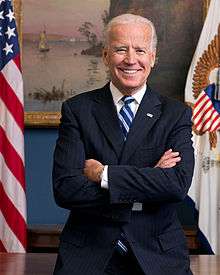
In the 2008 U.S. Presidential election, Senator Joe Biden was elected Vice President of the United States alongside Illinois Senator Barack Obama, who was elected President of the United States. Biden is the first Delawarean to run on a presidential ticket, and the first Delawarean to be elected and hold the office. Biden assumed the Vice Presidency on January 20, 2009 and served until January 20, 2017.
- Vice President of the United States: Joe Biden
Statewide officers
Executive branch
Since 2017, Democrats control four of the six statewide elected offices.
- Governor: John Carney
- Lieutenant Governor: Bethany Hall-Long
- Attorney General: Matt Denn
- Commissioner of Insurance: Trinidad Navarro
State Senate
In 2017, Democrats control 11 of the statewide elected offices.[3] State Senators must be citizens of the United State and have resided in Delaware for three years. Candidates must also have been a resident of their respective district for at least one year preceding their election. The age requirement to run for this elected seat is 27 years old.
- 1st Senate District: Harris McDowell III
- 2nd Senate District: Margaret Henry
- 3rd Senate District: Robert Marshall'
- 8th Senate District: David Sokola
- 9th Senate District: Karen Peterson
- 10th Senate District: Stephanie Hansen
- 11th Senate District: Bryan Townsend
- 12th Senate District: 'Nicole Poore'
- 13th Senate District: David McBride
- 14th Senate District: Bruce Enis
- 17th Senate District: Brian Bushweller
Current makeup of Delaware State Senate
| District | Name | Party | First Elected | Residence | Seat up |
|---|---|---|---|---|---|
| 1 | Harris McDowell III | Dem | 1976 | North Wilmington | 2014 |
| 2 | Margaret Henry | Dem | 1994 | East Wilmington | 2012 |
| 3 | Robert Marshall | Dem | 1978 | West Wilmington | 2012 |
| 4 | Michael Katz | Dem | 2008 | Centerville | 2012 |
| 5 | Catherine Cloutier | Rep | 2000 | Heatherbrooke | 2014 |
| 6 | Liane Sorenson | Rep | 1995 | Hockessin | 2012 |
| 7 | Anthony Delcollo | Rep | 2016 | Elsmere | 2018 |
| 8 | Bryan Townsend | Dem | 2012 | Newark | 2014 |
| 9 | Karen Peterson | Dem | 2002 | Stanton | 2014 |
| 10 | Stephanie Hansen | Dem | 2017 | Middletown | 2018 |
| 11 | Anthony J. DeLuca | Dem | 1998 | Varlano | 2012 |
| 12 | Dorinda Connor | Rep | 1997 | Penn Acres | 2014 |
| 13 | David McBride | Dem | 1980 | Hawk's Nest | 2014 |
| 14 | Bruce Ennis | Dem | 2007 | Clayton | 2014 |
| 15 | David Lawson | Rep | 2010 | 2014 | |
| 16 | Colin R. J. Bonini | Rep | 1994 | South Dover | 2012 |
| 17 | Brian Bushweller | Dem | 2008 | North Dover | 2012 |
| 18 | F. Gary Simpson | Rep | 1999 | Milford | 2012 |
| 19 | Joseph W. Booth | Rep | 2009 | Georgetown | 2014 |
| 20 | George Bunting, Jr. | Dem | 1996 | Bethany Beach | 2014 |
| 21 | Robert Venables, Sr. | Dem | 1988 | Laurel | 2012 |
State House of Representatives
In 2011, Democrats control 26 of the 41 statewide elected offices.[4] Any candidate running for the House of Representatives must have lived in Delaware for three years and be a U.S. citizen. The candidate must also live in the district at least one year prior to running for office and be at least 24 years of age.
- 1st Representative District: Dennis Williams
- 2nd Representative District: Stephanie Bolden
- 3rd Representative District: Helene Keeley
- 4th Representative District: Gerald Brady
- 5th Representative District: Melanie George
- 6th Representative District: Debra Heffernan
- 7th Representative District: Bryon Short
- 8th Representative District: S. Quinton Johnson
- 9th Representative District: Rebecca Walker
- 10th Representative District: Dennis Williams
- 13th Representative District: John Mitchell Jr.
- 14th Representative District: Peter Schwartzkopf
- 15th Representative District: Valerie Longhurst
- 16th Representative District: James Johnson
- 17th Representative District: Michael Mulrooney
- 18th Representative District: Michael Barbieri
- 19th Representative District: Robert Gilligan
- 23rd Representative District: Teresa Schooley
- 24th Representative District: Edward Osienski
- 25th Representative District: John Kowalko, Jr.
- 26th Representative District: John Viola
- 27th Representative District: Earl Jaques, Jr.
- 28th Representative District: William Carson, Jr.
- 31st Representative District: Darryl Scott
- 32nd Representative District: E. Bradford Bennett
- 41st Representative District: John Atkins
Current make-up of Delaware House of Representatives
| District | Name | Party | First Elected | Residence |
|---|---|---|---|---|
| 1 | Dennis Williams | Dem | 1996 | Wilmington North |
| 2 | Stephanie Bolden | Dem | 2010 | |
| 3 | Helene Keeley | Dem | 1996 | Wilmington South |
| 4 | Gerald Brady | Dem | 2006 | Wilmington West |
| 5 | Melanie George | Dem | 2002 | Bear/Newark |
| 6 | Debra Heffernan | Dem | 2010 | |
| 7 | Bryon Short | Dem | 2007 | |
| 8 | S. Quinton Johnson | Dem | 2008 | Middletown |
| 9 | Rebecca Walker | Dem | 2010 | |
| 10 | Dennis Williams | Dem | 2008 | Talleyville |
| 11 | Gregory Lavelle | Rep | 2000 | Sharpley |
| 12 | Deborah Hudson | Rep | 2000 | Fairthorne |
| 13 | John Mitchell Jr. | Dem | 2006 | Elsmere |
| 14 | Peter Schwartzkopf | Dem | 2002 | Rehoboth |
| 15 | Valerie Longhurst | Dem | 2004 | Bear |
| 16 | James Johnson | Dem | 2002 | Jefferson Farms |
| 17 | Michael Mulrooney | Dem | 1998 | Pennwood |
| 18 | Michael Barbieri | Dem | 2008 | Newark |
| 19 | Robert Gilligan | Dem | 1972 | Sherwood Park |
| 20 | Nick T. Manolakos | Rep | 2006 | Limestone Hills |
| 21 | Michael Ramone | Rep | 2008 | Drummond Hill |
| 22 | Joseph Miro | Rep | 1998 | Pike Creek Valley |
| 23 | Teresa Schooley | Dem | 2004 | Newark |
| 24 | Edward Osienski | Dem | 2010 | |
| 25 | John Kowalko, Jr. | Dem | 2006 | Newark South |
| 26 | John Viola | Dem | 1998 | Newark |
| 27 | Earl Jaques, Jr. | Dem | 2008 | Glasgow |
| 28 | William Carson, Jr. | Dem | 2008 | Smyrna |
| 29 | Lincoln Willis | Rep | 2010 | |
| 30 | William Outten | Rep | 2004 | Harrington |
| 31 | Darryl Scott | Dem | 2008 | Dover |
| 32 | E. Bradford Bennett | Dem | 2008 | Dover |
| 33 | Harold Peterman | Rep | 2010 | |
| 34 | Donald Blakey | Rep | 2006 | |
| 35 | David Wilson | Rep | 2008 | Bridgeville |
| 36 | Harvey Kenton | Rep | 2010 | |
| 37 | Ruth Briggs King | Rep | 2009 | Georgetown/Lewes |
| 38 | Gerald Hocker | Rep | 2002 | Ocean View |
| 39 | Daniel Short | Rep | 2006 | Seaford |
| 40 | Clifford "Biff" Lee | Rep | 2000 | Laurel |
| 41 | John Atkins | Dem | 2008 (2003–2006) | Millsboro |
Federal officers in the 115th United States Congress
U.S. Senate
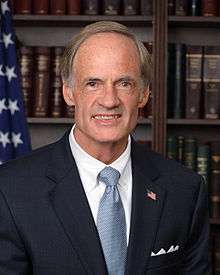
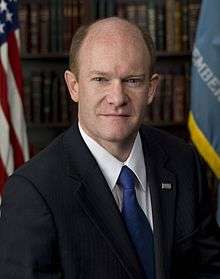
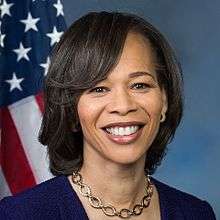
Democrats control both of Delaware's U.S. Senate seats:
- Class I: Tom Carper (Senior Senator)
- Class II: Chris Coons (Junior Senator)
U.S. House of Representatives
Democrats control Delaware's lone seat in the U.S. House:
See also
References
- 1 2 3 4 5 6 Boyer, William and Edward C. Ratledge. Delaware Politics and Government. Board of Regents of the University of Nebraska. 2009.
- 1 2 3 4 5 6 7 8 9 Party Platform, Delaware Democratic Party, http://www.deldems.org/about-us/platform/, accessed December 4th, 2011
- ↑ Delaware State Senate Home,http://legis.delaware.gov/Legislature.nsf/Lookup/SenateHome?open&nav=senate, Accessed November 15th, 2011
- ↑ Delaware House of Representatives,http://legis.delaware.gov/Legislature.nsf/Lookup/House_Home?open&nav=house, accessed November 15, 2011
